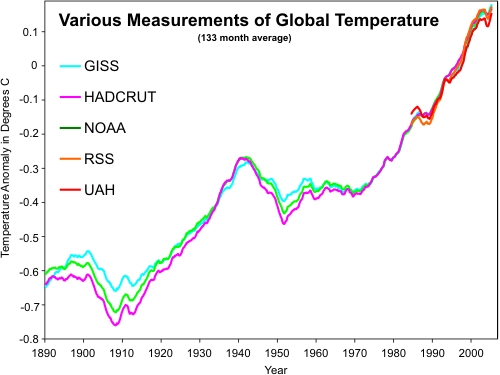Comparing all the temperature records
Posted on 23 December 2010 by John Cook
I've added a new graphic to the list of Hi-rez Climate Graphics: a composite of all the major global temperature records, going back to 1890 (obviously the satellite records only begin in the late 20th century). Many thanks to Benjamin Franz who sent me the spreadsheet of all the data:

Benjamin has published a series of useful graphs including a version of the graph above. The data comes from surface temperature measurements of NASA GISS, HadCRUT, NOAA plus the satellite measurements of lower atmosphere temperature by RSS and UAH. The data was originally compiled by Kelly O'Day from Climate Charts and Graphs who put all 5 datasets into a single spreadsheet. The problem is all the different temperature records use different base periods.
Temperature records are expressed as an anomaly (or variation) from a specified base period. For example, the base period for both satellite recoreds (UAH and RSS) is 1979 to 1998. So for example, when the UAH record says 0.5°C, it actually means the temperature is 0.5°C warmer than the average temperature over 1979 to 1998. The GISS base period is 1951 to 1980. HadCRUT use the base period 1961 to 1990. NOAA use 1971 to 2000. The choice of base period doesn't really matter as its the trend that's important, not the absolute values. Nevertheless, some people do get a little confused when comparing two temperature records that use different base periods.
To get around the problem of different base periods, Benjamin normalised all the datasets by calculating each temperature record's average value over the period 1980 to 2010. Then he calculated the temperature anomaly from the 1980 to 2010 base period. Thus each record now used the same base period and could be directly compared.
As surface temperature is a noisy signal, with plenty of variation from year to year, Benjamin calculated the long-term trend by calculating the 133 month moving average. That is what is shown in the graph above. The graph is also available in a number of formats:
- High resolution JPEG (1024 pixels wide)
- High resolution PNG (1024 pixels wide)
- Vector (Windows Metafile WMF)
- Vector (Scalable Vector Graphic SVG)
- Excel Spreadsheet
Now I would love to add the European Centre for Medium-Range Weather Forecasts (ECMWF) reanalysis to this graph. The ECMWF record covers the full globe but uses an independent technique to NASA to estimate warming in the Arctic regions. Their data is available on their website but I've never been able to penetrate their obtuse interface (no offence to the good folk at the ECMWF). So if anyone is able to post a link to the pertinent data or even better, hand it to me on a silver platter in Excel format (hint, hint), please be my guest :-)
P.S. - for a more rigorous treatment of this subject, Tamino at Open Mind has two recent blog posts worth a look: Odd Man Out and Comparing Temperature Data Sets.































 Arguments
Arguments






























Just a reminder to all, Dan's very cool AGU blog is Dan's Wild Wild Science Journal. BTW, the Twitter link on your blog doesn't work - do you still have a Twitter account?
I wonder if the fact that the European and Japanese records are published in the obtuse GRIB format are part of the reason why GISS, HadCRUT and NOAA are much more widely published online.
UPDATE: Okay, this graph seems to indicate they exclude the Arctic regions similar to HadCRUT, as does the fact that their global average shows 1998 as the hottest on record.
But why exclude all the temperature data throughout 2010? The 2010 temperatures are shown above - the green line. When we plot the linear trend from 1998 through to the end of 2010 (well, to very late 2010, we're not quite there yet), we get a positive trend (the red line).
It bears mentioning that neither trend are statistically significant. It's a very noisy signal and we're looking at a short period. The lesson here is the danger of drawing solid conclusions from short periods. You assume a cooling phase when you plot the trend to December 2009. But you find a warming trend if you extend it to November 2010. You need to look at longer periods to get a result that is statistically significant.
ECMWF global temperature data comes in two datasets: the 40-year reanalysis, covering 1957-2002, and the "interim" re-analysis, covering 1989-present. While the data is available online, it is gridded, making retrieval in this form difficult at best. However, a graph of ECMWF global temps can be found here: LINK This looks quite similar to GISS, in that the 1977-2010 slope is roughly .18 K per decade, and in that the 1998 peak has been surpassed 4 times (and essentially tied twice).